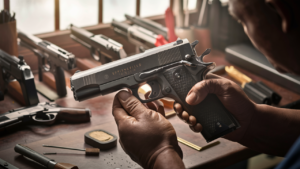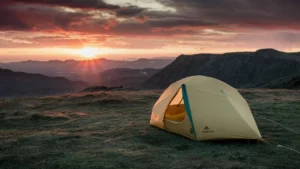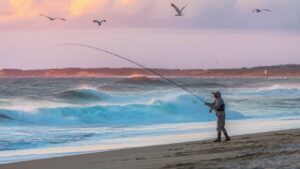Camping in high-wind environments can be challenging. Proper tent stability is crucial for safety and comfort.
Understanding guyline and stake configurations is key to reinforcing your tent against strong winds. High winds can easily damage tents if they aren’t properly secured. Guylines and stakes play a vital role in keeping your tent stable. When set up correctly, they distribute tension evenly, preventing collapses and damage.
This guide will explore different configurations and techniques. These methods will help you stay safe and secure, even in challenging weather. Whether you’re an experienced camper or a beginner, mastering these setups is essential for any outdoor adventure. So, let’s dive into the best ways to reinforce your tent and enjoy a worry-free camping experience.
Introduction To Guyline And Stake Configurations
Have you ever found yourself battling the elements, trying to keep your tent standing in high winds? It can be a real challenge. But with the right guyline and stake configurations, you can reinforce your tent’s stability significantly. This guide will give you practical tips to ensure your tent remains secure, no matter the weather.
Importance Of Tent Stability
Tent stability is crucial for a safe and comfortable outdoor experience. A stable tent keeps you protected from the elements and ensures a good night’s sleep. Without proper stability, your tent can collapse or be blown away, leaving you exposed to harsh weather conditions.
Think about your last camping trip. Did you feel confident your tent would hold up in a storm? If not, it’s time to reconsider your setup. Stable tents also protect your gear from getting damaged or wet, making your overall experience more enjoyable.
Challenges In High-wind Environments
High winds can be unpredictable and relentless. They test the limits of your tent’s design and setup. One common challenge is ensuring that your tent’s shape and structure can withstand strong gusts.
Another issue is the terrain. Rocky or sandy grounds can make it difficult for stakes to hold. In these cases, specialized stakes or alternative anchoring methods can be a lifesaver. Have you ever had your stakes pulled out by the wind? It’s frustrating and can be dangerous.
So, what’s the solution? Proper guyline and stake configurations can make all the difference. By learning a few simple techniques, you can significantly enhance your tent’s resilience against high winds. Stay tuned for practical tips and strategies that will keep your tent standing tall.

Types Of Guylines
Guyline types, such as reflective and non-reflective, play a crucial role in tent stability during high winds. Proper stake configurations, including V and Y shapes, enhance the tent’s resistance against strong gusts.
When camping in high-wind environments, having the right guylines can make a world of difference in your tent’s stability. Different types of guylines offer varying levels of strength, durability, and usability. Knowing which one to choose can enhance your camping experience and keep your tent firmly anchored even in challenging weather conditions.
Materials Used
The material of your guylines greatly affects their performance and reliability.
Nylon is a common choice due to its elasticity and affordability. It’s flexible, which helps absorb wind shocks, but it can stretch when wet.
Dyneema is another popular option, known for its incredible strength and lightweight nature. It doesn’t stretch, even when wet, making it reliable in all weather conditions.
Polyester guylines strike a balance between nylon and Dyneema. They offer moderate stretch and are more resistant to UV light, which can degrade other materials over time.
Strength And Durability
Choosing the right guyline also depends on its strength and durability.
Nylon guylines are strong but can lose tension over time, especially in wet conditions. They are best for less extreme environments.
Dyneema guylines, on the other hand, are incredibly strong and durable. They maintain their tension well, which is crucial for high-wind environments. However, they can be more expensive.
Polyester guylines offer a good compromise. They are durable and maintain tension better than nylon but may not match the strength of Dyneema.
When I first started camping in windy areas, I used nylon guylines and found myself constantly adjusting them. Switching to Dyneema made a significant difference, providing a stable and worry-free camping experience.
Now, here’s a question for you: Have you ever faced issues with your tent’s stability due to inadequate guylines? If so, consider the material and durability aspects the next time you gear up for an adventure.
Understanding the types of guylines and their characteristics can help you make an informed decision. Choose wisely to ensure your tent remains secure, no matter the weather.
Stake Options For Stability
When camping in high-wind environments, your tent’s stability is critical. Proper stake configurations can make the difference between a peaceful night and a disaster. Let’s explore the various options available to ensure your tent stays put.
Types Of Stakes
Different stakes serve different purposes. Understanding the types can help you choose the right one for your situation.
- Shepherd’s Hook Stakes: These are lightweight and easy to install. Perfect for soft ground.
- Y-Stakes: Offer excellent holding power in various soil types. They are a bit heavier but more versatile.
- V-Stakes: Great for sandy or loose soil. Their design helps to anchor the tent securely.
- Nail Stakes: Ideal for hard, rocky ground. They penetrate the soil easily and are very durable.
Each type has its own advantages. Choose the one that best matches the terrain you’ll be camping in.
Materials And Their Benefits
The material of your stakes can significantly impact their effectiveness. Let’s look at the common materials used.
- Aluminum: Lightweight and rust-resistant. A good all-around choice for most campers.
- Steel: Extremely strong and durable. Best for tough conditions but can be heavier to carry.
- Titanium: Offers the best strength-to-weight ratio. Ideal for backpackers who need to minimize weight without sacrificing durability.
- Plastic: Affordable and lightweight. Suitable for casual camping but not recommended for high-wind conditions.
Consider the benefits of each material. For instance, I once found myself in a windy mountain range. My aluminum stakes held up well, but my friend’s plastic ones did not. Lesson learned: always match your stakes to the environment.
What kind of terrain do you usually camp in? Choosing the right stake type and material can save you a lot of trouble. Make informed choices and enjoy your outdoor adventures with peace of mind.
Setting Up Guylines
Setting up guylines is essential for ensuring your tent remains stable, especially in high-wind environments. Properly deployed guylines can make the difference between a restful night’s sleep and a sleepless battle with a flapping tent. Here’s how to get it right.
Choosing The Right Angle
The angle at which you set your guylines is critical. Aim for a 45-degree angle away from the tent. This angle provides the best balance of tension and stability.
Too steep an angle, and the guyline might slip. Too shallow, and it might not provide enough tension. Consider the terrain as well—rocky or uneven ground might require some adjustment.
Imagine you are setting up your tent on a windy cliffside. The right angle can keep your tent grounded and safe, even in the strongest gusts.
Securing Knots
Mastering knot-tying can seem daunting, but you only need a few key knots. The Taut-Line Hitch is a versatile choice—it’s adjustable and holds well under tension.
Another option is the Bowline Knot, which is excellent for creating a secure loop at the end of your guyline. Practice these knots at home before your trip. It’s easier to learn in a calm environment.
Have you ever woken up to find your tent collapsed because a knot came loose? That’s an experience you don’t want to repeat. Secure knots are your best defense.
Setting up guylines correctly can seem like a small detail, but it has a big impact. What’s your go-to knot for securing your tent? Share your tips and help fellow campers stay safe!
Proper Stake Placement
Proper stake placement is crucial for tent stability in high-wind environments. Good placement keeps your tent firm and secure. Misplaced stakes can cause your tent to collapse. Understanding ground conditions and optimal depth helps in proper stake placement. Let’s explore these key aspects in detail.
Ground Conditions
Different ground conditions affect stake placement. Hard ground offers solid support. Soft ground can be tricky. Rocks can block stakes. Sand needs special stakes. Snow requires even more care. Always assess the ground before pitching your tent.
Optimal Depth
Stake depth is vital. Too shallow, and they pop out. Too deep, and they lose grip. Aim for a 45-degree angle. This ensures the best hold. Push stakes at least six inches deep. This depth provides a strong anchor. Adjust based on soil type. Hard soil may need less depth. Soft soil may need more. Test the hold by tugging lightly. If it moves, adjust the depth. Secure stakes mean a stable tent.
Advanced Guyline Techniques
Strengthen tent stability with advanced guyline and stake configurations. These methods ensure tents remain secure in high-wind environments. Enhance your camping experience by learning these essential techniques.
When camping in high-wind environments, mastering advanced guyline techniques can be the difference between a restful night and a collapsed tent. Strengthening your tent’s stability is crucial, especially when Mother Nature decides to throw a tantrum. Here are some practical strategies to ensure your shelter remains steadfast.
Cross Bracing
Cross bracing is a simple yet effective technique to bolster your tent’s stability. By creating an ‘X’ pattern with your guylines, you distribute the wind force more evenly.
Imagine the wind hitting your tent from multiple angles. Cross bracing helps spread this force, reducing the pressure on any single point.
To achieve this, attach guylines to opposite corners of your tent, then stake them out at a 45-degree angle. This setup provides a solid foundation, minimizing the risk of your tent poles bending or breaking.
Multiple Anchor Points
Relying on a single anchor point can be risky. Using multiple anchor points offers a more secure and reliable setup.
Consider this: if one stake pulls out, your tent could collapse. But with multiple anchors, you have a backup plan in place.
Distribute your guylines around the tent, securing them to various solid points like rocks, trees, or additional stakes. This method ensures that even if one anchor fails, your tent remains upright.
Applying these advanced guyline techniques can significantly enhance your tent’s stability. Have you tried cross bracing or using multiple anchor points? What’s your go-to method for securing your tent in high winds? Share your thoughts and experiences in the comments below!
Common Mistakes To Avoid
Incorrect guyline and stake configurations can compromise tent stability in high winds. Ensure proper angles and tension to avoid issues. Secure stakes deeply into the ground for better anchoring.
When setting up your tent in high-wind environments, having a strong and stable configuration is critical. However, there are common mistakes that many campers make, which can compromise tent stability. Understanding these errors will help you avoid them and ensure your shelter stays secure even in the fiercest gusts.
Loose Tension
One frequent mistake is having loose guylines. Loose lines can cause your tent to collapse or flap excessively in the wind. Always ensure that your guylines are taut.
Check them regularly, especially after strong gusts. Loose lines can also lead to wear and tear on your tent fabric. Keep a tensioner on hand to make adjustments easier.
Improper Angles
Another mistake is staking guylines at improper angles. Angle your stakes at around 45 degrees from your tent. This provides the best support and distributes tension evenly.
Avoid staking too close to the tent body. This can reduce the effectiveness of your guylines. Experiment with different angles to see what works best in varying conditions.
When you set up your tent, think about how the wind will hit it. Are your lines and stakes ready for a change in wind direction? Proper planning and setup will save you headaches later.
By avoiding these common mistakes, you can enhance your tent’s stability. What other mistakes have you made or seen others make? Share your experiences and tips in the comments below!
Tips For High-wind Conditions
Ensure your tent stays stable in high winds by using strong guylines and securing stakes properly. Angle the stakes outward and tighten the guylines for maximum support.
Tips for High-Wind Conditions
Camping in high-wind environments can be challenging. But with the right techniques, you can ensure your tent remains stable and secure. Here are some essential tips to help you reinforce your tent’s stability.
Reinforcing Critical Points
Focus on the tent’s most vulnerable areas. These include the corners and the points where the guylines are attached.
Use stronger stakes, such as heavy-duty aluminum or steel ones, to secure these critical points.
Double up on guylines for added strength. Attach two lines to each critical point and anchor them at different angles.
Regular Inspections
Inspect your tent setup regularly. This is especially important before and after a storm.
Check the tightness of the guylines. Loose lines can cause the tent to flap and potentially collapse.
Ensure the stakes are firmly in the ground. If they are loose, re-anchor them immediately.
—
Personal experience has shown that a well-secured tent can withstand surprisingly strong winds. During a camping trip in the mountains, I learned the importance of doubling up on guylines after a sudden gust nearly toppled my tent.
What steps will you take to prepare for high-wind camping? Share your thoughts and experiences in the comments below!
Conclusion And Best Practices
Securing your tent in high-wind environments is crucial. Proper guyline and stake configurations can make a big difference. This section covers key points and best practices for campers. Keep reading to learn more.
Summary Of Key Points
Guyline and stake configurations improve tent stability. High-wind conditions require strong setups. Use multiple guylines for extra security. Choose the right stake for the ground type. Ensure all lines are tight and well-angled. Check your setup regularly.
Recommendations For Campers
Carry extra guylines and stakes. Practice setting up your tent at home. Check weather forecasts before your trip. Adjust your setup based on wind direction. Use rocks or logs to anchor stakes if needed. Inspect your tent for wear and tear. Replace damaged parts promptly.
Frequently Asked Questions
How Do You Secure Tents In High Winds?
Secure tents in high winds by using strong stakes and guylines. Choose a sheltered location. Reinforce with sandbags or rocks. Tighten all ropes and check regularly. Opt for a low-profile tent design.
What Tent Stakes Are Good For High Winds?
Heavy-duty tent stakes, such as aluminum or steel, are best for high winds. Choose spiral or screw-in stakes for added stability.
What Is The Best Tent Shape For High Winds?
The best tent shape for high winds is a geodesic or dome design. These shapes offer stability and strength.
Why Use Guy Lines On Tents?
Guy lines stabilize tents, preventing collapse in wind. They increase interior space by pulling fabric taut. Essential for windy conditions.
Conclusion
Reinforcing tent stability in high-wind environments is crucial for safety. Using proper guyline and stake configurations helps keep your tent secure. Practice setting up your tent at home first. This ensures you are prepared in the wild. Check all knots and lines regularly.
This simple routine can prevent accidents. Stay safe and enjoy your outdoor adventure.








